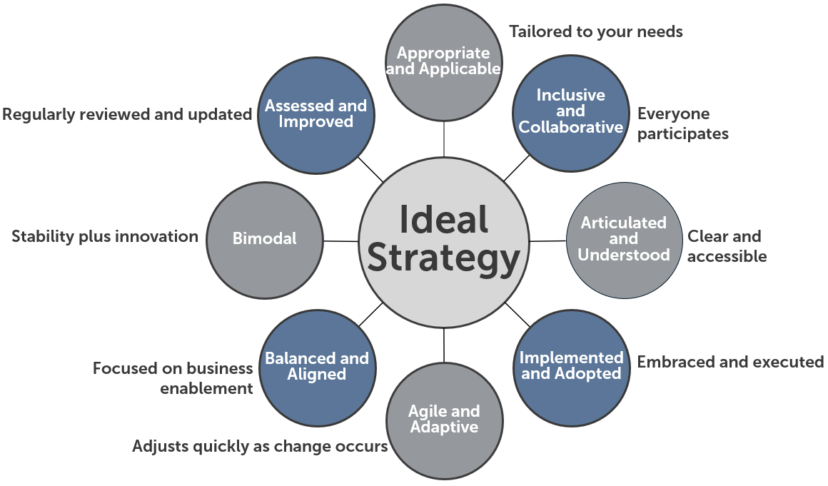The (Imaginary) Ideal IT Strategy
Many business leaders, who have a vested interest in getting maximum value and innovation from their organization’s investments in information technology, are faced with some daunting challenges. From rapidly changing critical business needs to unprecedented disruptions in the workforce environment, IT is under more pressure than ever to sustain existing capabilities while simultaneously creating transformative new ones.
The key to surviving and thriving while navigating the rocky landscape of modern IT, is to start with a great information technology strategy. Strategy generally involves setting goals and priorities, determining actions to achieve the goals, and mobilizing resources to execute those actions, usually in the face of incomplete information and dynamic circumstances. Unfortunately, many organizations struggle with both the initial strategic planning efforts, and with adjusting and updating their strategy when things change.
Why is having a great strategy critically important? What bad things are likely to happen when your strategy is less-than-great? Some organizations rush headlong into action, with no real plan-of-attack or much concern for later consequences.
They often focus too much on chasing the latest trends and products, without ensuring that what they already have is providing the needed and expected value. Other types of firms are indecisive and unable to commit to a course of action.
While their existing environment is usually well-tended, they usually adopt new technologies more slowly than their peers, perhaps missing potentially transformative opportunities as a result. Both these examples, along with countless others, represent fatal flaws of strategy. The consequences can certainly be tragic, up to and including death (of the organization).
How can you know if your IT Strategy is great, or flawed? One useful means of assessing the state of your strategy is to compare it to an Ideal Strategy model, along multiple relevant dimensions. In theory, an Ideal Strategy would provide
perfect solutions to all problems and challenges, it would ensure the sustainability of the organization under any conditions and would result in maximum value with minimum investment and effort. Of course, such a ‘perfect’ strategy would only be possible in an imaginary world, since the real world is far too messy and imperfect.
If this (Imaginary) Ideal Strategy were in fact feasible, what would it look like? What considerations would have to be taken into account? What elements would have to be included, in order to achieve such perfection?
Figure 1 shows many attributes that an Ideal Strategy would have to have, all in perfect proportion to one another:

In order to be ‘Ideal’, an IT Strategy would necessarily be:
Appropriate and Applicable – Tailored to the organization’s needs, relevant and necessary
Inclusive and Collaborative – Everyone participates, transparent and open
Articulated and Understood – Clear and accessible, readily available, easy to comprehend for all
Implemented and Adopted – Embraced and executed, universally recognized and utilized
Agile and Adaptive – Quickly adjustable as change occurs, flexible and accommodating
Balanced and Aligned – Focused on business enablement, coordinated and consistent
Bimodal – Combining stability and innovation, predictability and exploration
Assessed and Improved – Regularly reviewed and updated, dynamically and actively maintained
Of course, the notion of an ‘Ideal Strategy’ that mixes all these elements into a harmonious, holistic and highly effective
approach to IT management is obviously purely fictitious. However, despite the ‘imaginary nature’ of such a thing, it is
worth considering as a way to assess and improve upon real-world strategy. Just because perfection is unreachable, that does not mean it is not worth striving for!
for more info on IT Strategy, click here



